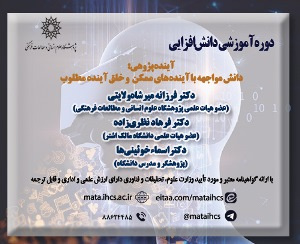فهم مؤلفه های فضایی-کالبدی مکان در تولید سرمایه اجتماعی در جوامع محلی: رهیافت نظریه داده بنیاد (مورد مطالعه: محله رودکی، منطقه 10 شهرداری تهران)
آرشیو
چکیده
زمینه و هدف: اهمیت موضوع سرمایه اجتماعی در دهه های اخیر، ادبیات نظری شهرسازی را به تحقیق پیرامون عوامل مکانی موثر بر سرمایه اجتماعی در محیط های شهری واداشته است. با این حال پژوهش های نسبتا اندکی در رابطه با این مفهوم در عرصه شهرسازی کشور انجام شده است. با توجه به غفلت از این مفهوم در ادبیات پژوهشی کشور، توجه و بازتعریف آن در پژوهش های شهرسازی جاری ضروری به نظر می رسد. درک عوامل موثر بر سرمایه اجتماعی در محلات شهری می تواند منجر به معرفی ابزارهایی در شهرسازی شود که به پیدایش و ارتقای سرمایه اجتماعی در محلات شهری کشور در شرایط امروزین کمک نماید.روش بررسی: به منظور پاسخ به سوالات تحقیق، از روش کیفی نظریه داده بنیاد (گراندد تئوری) استفاده شده است. براساس روش تحقیق و در پاسخ به پرسش «چیستی» پژوهش، به کشف مولفه های کالبدی مکان مورد مطالعه که بر فرآیندهای تولید سرمایه اجتماعی در جوامع محلی تاثیر گذار هستند اقدام نموده ایم؛ و در پاسخ به پرسش «چگونگی» تحقیق، رابطه ی مولفه های کالبدی با مولفه های سازنده ی سرمایه اجتماعی در بستر مطالعه را مورد فهم و تفسیر قرار داده ایم.یافته ها و نتیجه گیری: یافته های پژوهش نشان می دهد که وجود فضاهای عمومی، مراکز عمده فعالیتی، محورها و فضاهای مخصوص پیاده و توجه به ویژگی و نقش معابر را می توان به عنوان تاثیر گذار ترین ابزار های کالبدی ارتقا دهنده سرمایه اجتماعی در محله رودکی برشمرد. در نهایت نتیجه اصلی این پژوهش موید آن است که ارتقای سرمایه اجتماعی با بهبود ساختار کالبدی محلات در راستای بسترسازی تامین تیازهای فیزیکی، روحی و تسهیل کننده ی کنش های اجتماعی ساکنان ارتباط تنگانگی دارد.Understanding the physical-spatial components of place in the production of social capital in local communities: A data-based theory approach (Case study: Rodaki neighborhood, region 10 of Tehran Municipality)
Background and Aim: The importance of social capital in recent decades has led the theoretical literature of urban planning to research the physical factors affecting social capital in urban environments. However, relatively few studies have been carried out concerning this concept in Iran`s urban planning field. Considering the neglect of this concept in the theoretical literature in the past decades, it seems necessary to pay attention to and redefine it in current urban planning studies. Discovering and understanding the factors affecting social capital can lead to the introduction of urban planning tools that will help create and promote social capital in urban neighborhoods of Iran in today's conditions.Methods: In order to answer the research questions in the studied area, the qualitative method of grounded theory has been used. This method focuses on understanding reality within the research situation and building a situated theory. Based on research method and in response to the "what" question of the research, it has tried to discover the physical components of the studied location that impact the processes of social capital production in local communities. To answer the "how" question of the research, the relationship between the physical components and the constructive components of social capital in the context of the study has been interpreted.Findings and Conclusion: The findings show that the existence of public spaces, major activity centers, streets, and special pedestrian spaces and paying attention to the characteristics and role of paths can be considered the most effective physical tools for promoting social capital in the Rudaki neighborhood. Finally, the main result of this research confirms that the creation and promotion of social capital are closely related to the improvement of the physical structure of the neighborhoods in the direction of creating a platform for providing physical and mental needs and facilitating the social actions of the residents.




